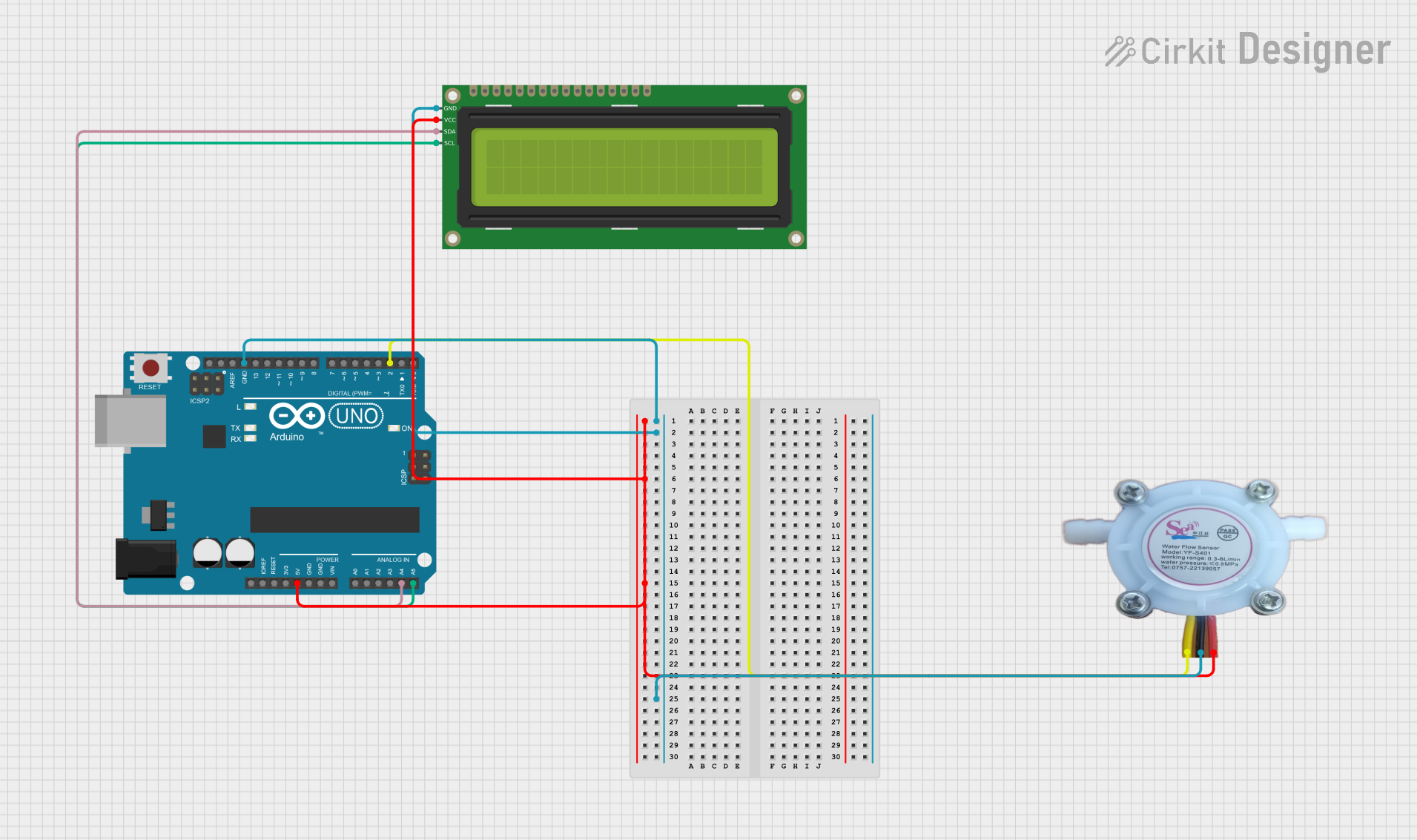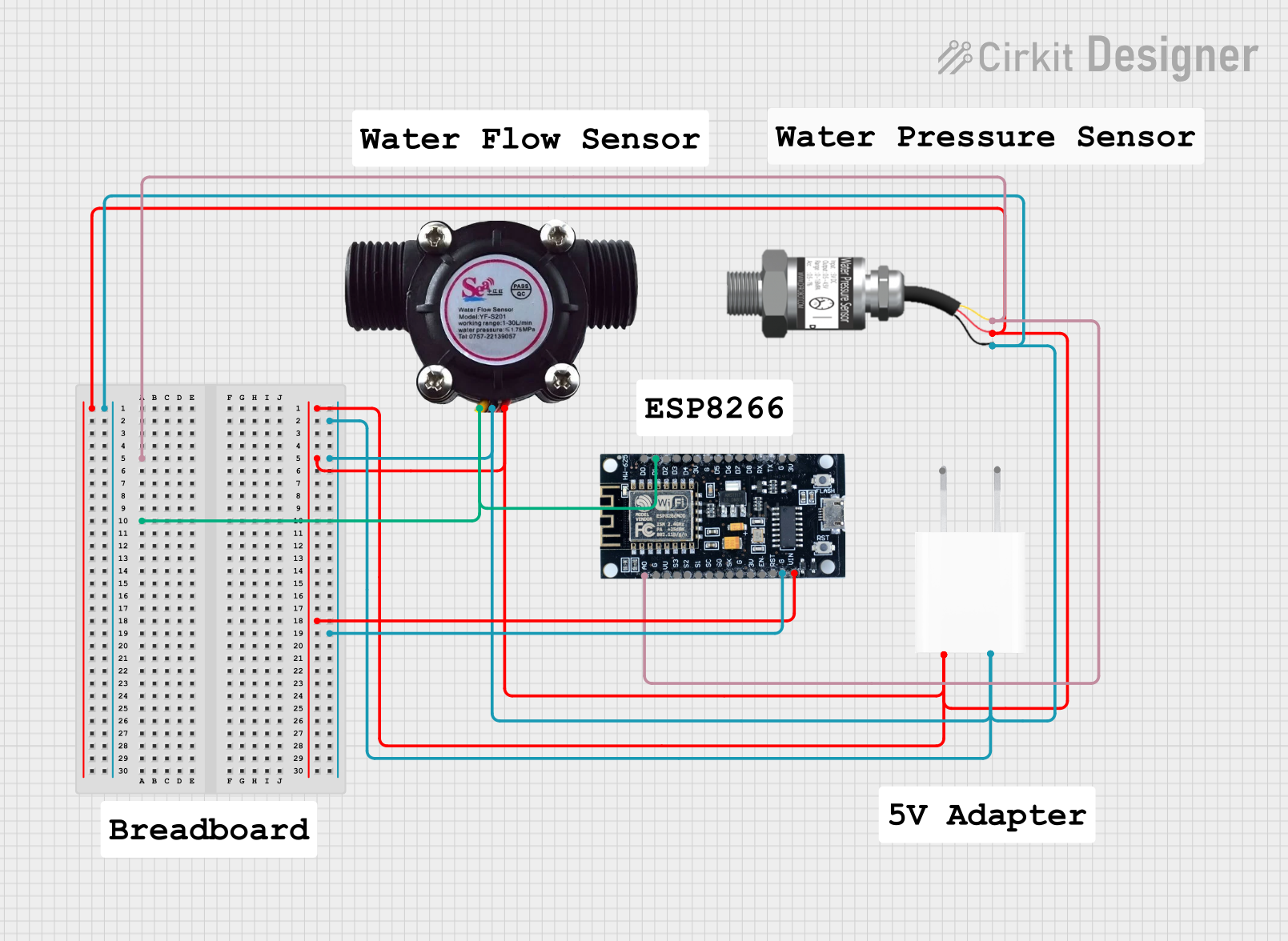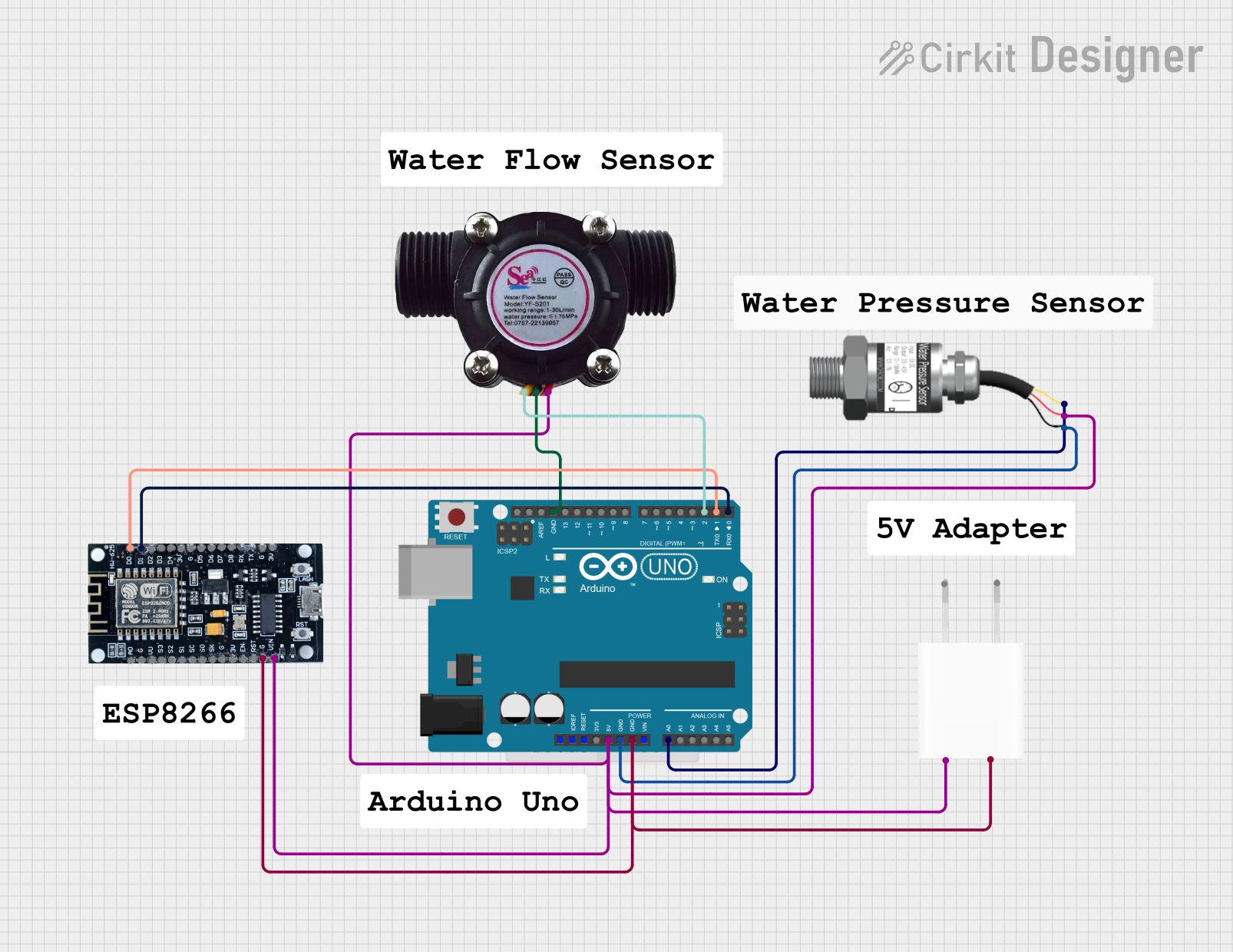
How to Use Water Flow Sensor: Examples, Pinouts, and Specs

 Design with Water Flow Sensor in Cirkit Designer
Design with Water Flow Sensor in Cirkit DesignerIntroduction
The Water Flow Sensor is a device designed to measure the flow rate of water in a system. It operates by detecting the movement of water through a pipe and converting it into electrical pulses, which can then be interpreted to calculate the flow rate. This sensor is widely used in applications such as irrigation systems, plumbing, water management, and industrial fluid monitoring. Its ability to provide real-time flow data makes it an essential component in systems requiring precise water usage monitoring and control.
Explore Projects Built with Water Flow Sensor

 Open Project in Cirkit Designer
Open Project in Cirkit Designer
 Open Project in Cirkit Designer
Open Project in Cirkit Designer
 Open Project in Cirkit Designer
Open Project in Cirkit Designer
 Open Project in Cirkit Designer
Open Project in Cirkit DesignerExplore Projects Built with Water Flow Sensor

 Open Project in Cirkit Designer
Open Project in Cirkit Designer
 Open Project in Cirkit Designer
Open Project in Cirkit Designer
 Open Project in Cirkit Designer
Open Project in Cirkit Designer
 Open Project in Cirkit Designer
Open Project in Cirkit DesignerTechnical Specifications
Below are the key technical details of a typical Water Flow Sensor:
- Operating Voltage: 5V to 24V DC
- Output Signal: Pulse signal (square wave)
- Flow Rate Range: 1 to 30 liters per minute (varies by model)
- Accuracy: ±2% (depending on the model and conditions)
- Maximum Water Pressure: 1.75 MPa
- Connector Type: 3-pin (VCC, GND, Signal)
- Material: Plastic or brass (depending on the model)
- Operating Temperature: -25°C to 80°C
Pin Configuration and Descriptions
The Water Flow Sensor typically has a 3-pin connector. The pinout is as follows:
| Pin Name | Description | Notes |
|---|---|---|
| VCC | Power supply input (5V to 24V DC) | Connect to the power source. |
| GND | Ground | Connect to the circuit ground. |
| Signal | Pulse output signal | Outputs pulses proportional to the flow rate. |
Usage Instructions
How to Use the Water Flow Sensor in a Circuit
Wiring the Sensor:
- Connect the VCC pin of the sensor to a 5V or 12V power supply (depending on the sensor model).
- Connect the GND pin to the ground of your circuit.
- Connect the Signal pin to a digital input pin of your microcontroller (e.g., Arduino).
Interpreting the Signal:
- The sensor outputs a series of pulses on the Signal pin. The frequency of these pulses is directly proportional to the flow rate of water.
- Use the sensor's datasheet to determine the pulse-to-flow rate conversion factor (e.g., pulses per liter).
Example Circuit:
- Use a pull-up resistor (e.g., 10kΩ) on the Signal pin if required by your microcontroller.
Arduino UNO Example Code
Below is an example code to interface the Water Flow Sensor with an Arduino UNO:
// Water Flow Sensor Example Code
// This code reads pulses from the sensor and calculates the flow rate in liters/minute.
const int sensorPin = 2; // Signal pin connected to digital pin 2
volatile int pulseCount = 0; // Variable to store pulse count
float flowRate = 0.0; // Flow rate in liters per minute
unsigned long previousMillis = 0; // Timer for flow rate calculation
const unsigned long interval = 1000; // Interval for calculations (1 second)
// Interrupt Service Routine (ISR) to count pulses
void pulseCounter() {
pulseCount++;
}
void setup() {
pinMode(sensorPin, INPUT_PULLUP); // Set sensor pin as input with pull-up
attachInterrupt(digitalPinToInterrupt(sensorPin), pulseCounter, RISING);
Serial.begin(9600); // Initialize serial communication
}
void loop() {
unsigned long currentMillis = millis();
// Calculate flow rate every second
if (currentMillis - previousMillis >= interval) {
previousMillis = currentMillis;
// Conversion factor (pulses per liter) - check your sensor's datasheet
float calibrationFactor = 4.5;
// Calculate flow rate in liters per minute
flowRate = (pulseCount / calibrationFactor) / (interval / 1000.0);
// Reset pulse count for the next interval
pulseCount = 0;
// Print flow rate to the Serial Monitor
Serial.print("Flow Rate: ");
Serial.print(flowRate);
Serial.println(" L/min");
}
}
Important Considerations and Best Practices
- Ensure the sensor is installed in the correct orientation (check the arrow on the sensor body for flow direction).
- Avoid exposing the sensor to water temperatures or pressures beyond its rated limits.
- Use a filter upstream of the sensor to prevent debris from clogging or damaging the internal components.
- Calibrate the sensor for your specific application to ensure accurate readings.
Troubleshooting and FAQs
Common Issues and Solutions
No Output Signal:
- Check the wiring connections (VCC, GND, and Signal).
- Ensure the power supply voltage matches the sensor's requirements.
- Verify that water is flowing through the sensor.
Inaccurate Flow Rate Readings:
- Confirm the calibration factor matches the sensor's datasheet.
- Check for air bubbles or debris in the water line.
- Ensure the sensor is installed in a straight section of the pipe to avoid turbulence.
Intermittent Signal:
- Inspect the wiring for loose connections or damage.
- Use a pull-up resistor on the Signal pin if the output is unstable.
FAQs
Q: Can the Water Flow Sensor measure other liquids besides water?
A: Most sensors are designed specifically for water. Using them with other liquids may affect accuracy or damage the sensor. Check the manufacturer's specifications for compatibility.
Q: How do I know the calibration factor for my sensor?
A: The calibration factor (pulses per liter) is typically provided in the sensor's datasheet. If unavailable, you may need to perform a manual calibration.
Q: Can I use the sensor with a 3.3V microcontroller?
A: Some sensors can operate at 3.3V, but others require a higher voltage. Use a level shifter or voltage divider if necessary, and check the sensor's specifications.
By following this documentation, you can effectively integrate and troubleshoot a Water Flow Sensor in your projects.